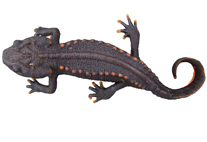FrogEyes
Active member
- Joined
- Sep 5, 2010
- Messages
- 908
- Reaction score
- 41
- Points
- 28
- Location
- Southern Minnesota
- Country
- Canada
As I have grown fond of saying - another new herp species of interest to enthusiasts was described tomorrow:
The first crocodile salamander formally recognized from Laos is described as a new species of the T.asperrimus group (subgenus Yaotriton), from the Phou Ak escarpment. This is the southernmost member of the genus to date, being 400km south of the type locality of T.vietnamensis. The species is distinct in geography, morphology, and both nDNA and mtDNA. The genus has long been suspected in northern Laos, but not yet confirmed there.
Abstract:
http://www.mapress.com/zootaxa/2010/f/z02650p032f.pdf
Image (manually coded, hope it works the first time):

The first crocodile salamander formally recognized from Laos is described as a new species of the T.asperrimus group (subgenus Yaotriton), from the Phou Ak escarpment. This is the southernmost member of the genus to date, being 400km south of the type locality of T.vietnamensis. The species is distinct in geography, morphology, and both nDNA and mtDNA. The genus has long been suspected in northern Laos, but not yet confirmed there.
Abstract:
http://www.mapress.com/zootaxa/2010/f/z02650p032f.pdf
Image (manually coded, hope it works the first time):

